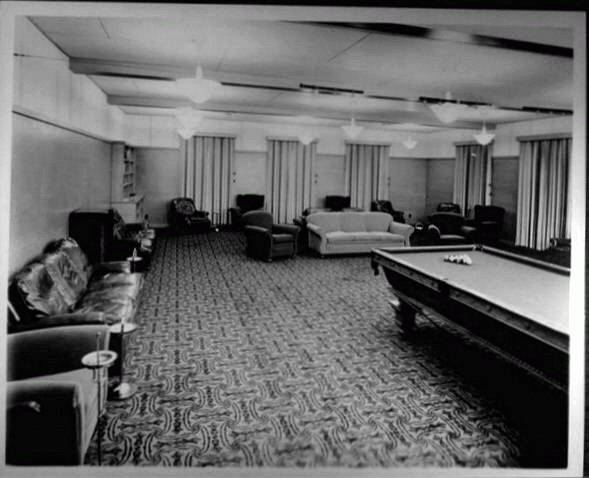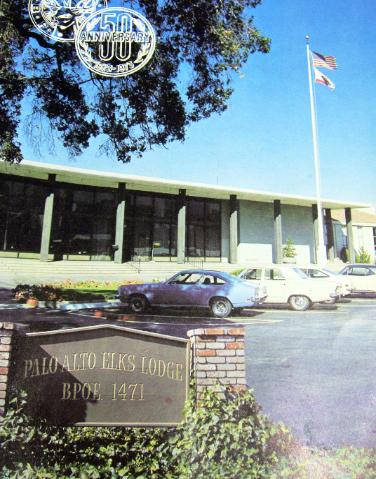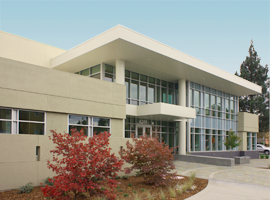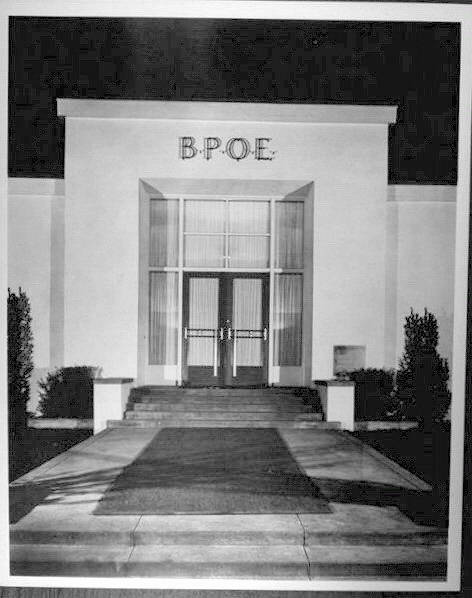The Palo Alto Elks: A Whole New Order
Note: This article was first published in 2007
The Benevolent and Protective Order of Elks has been donating to charities, providing college scholarships and giving back to the community for more than 80 years in Palo Alto --- but sadly the state of the fraternal organization these days may best be symbolized by an empty parking lot. Standing at 4249 El Camino Real
in South Palo Alto, the lonely and somewhat somber wood-paneled headquarters of the Palo Alto Elks is set back from the main street behind a two acre swath of empty asphalt parking lot. There was a time when such a plethora of space was needed --- the Elks grew by leaps and bounds to a peak of about 3,700 members in the 1970s. But in the last three decades, the Elks, like other fraternal organizations around the
nation, have seen their membership shrink rapidly. Now comprised of less than 800 members, the average Elk is said to be over 70 years old. Facing possible extinction, the Elks are now proposing a bold plan to try to regain their stride.
Using that empty land to their advantage, the Elks have sold off 5 acres of their grounds to housing developers and will be using the proceeds to build a smaller, ultra-modern and more family-oriented center closer to El Camino Real. The center will have better women’s facilities, 1,600 square feet of childcare space, and group exercise rooms, along with the billiards room, indoor and outdoor pool and squash courts that are more standard Elk infrastructure. With these new investments, the Elks will try to redefine themselves to a new generation --- attempting to stay ahead of the changing times, despite a history of often lagging behind them.
That history began in 1923, when 100 original Elks began a Palo Alto chapter, moving in to Downtown’s Fraternal Hall (where today one might find frat boys of a different sort sake-bombing at Miyake’s). The Palo Alto Elks became Lodge #1471, joining more than a million other Elks around the nation. Throughout
their history, the Elks have meant different things to different members: camaraderie, fellowship, squash games, low-priced beer, insurance packages, pool use, exercise facilities, a sense of belonging. There has also been a wide range of members, from dyed-in-the-wool enthusiasts to those who join for use of the facilities.
But the Elks are about a lot more than just a good weight room and an Olympic sized pool. Through the years, the Elks have distinguished themselves by heartily giving back to the community. A story in the Palo Alto Times in 1925 tells of 150 Elks who brought surprise Christmas baskets to some 90 Palo Alto families in need. During the war years, the Elks set out to purchase $150,000 in war bonds to “buy a real bomber for our armed forces.”
In the mid 1950s the Elks fought hard in the fight against cerebral palsy, paying for mobile therapy units and trained technicians to aid victims in the mountain and desert counties of California. And in 1975, a cast of more than 100 Elks (many dressed in drag) put on an epic performance of “Cleopatra --- Queen of the Nile,” with all proceeds being donated to charity. Through the decades, the Elks have sponsored scouting groups and little league teams, entertained sick kids, provided medical and dental services for low income children, sponsored students in foreign exchange programs, and held parties for disabled veterans. Many thankful recipients in Palo Alto say that the initials BPOE stand for “Best People on Earth” as much as “Benevolent and Protective Order of Elks.”
But the Elks have always seemed to run counter to the tides of history. Perhaps it is in the roots of the organization’s purpose. The Elks began in a time when it was commonplace for men to be joiners --- in those days before radio, television, and year-round professional sports leagues to follow, many working men would join one or often more organizations --- be it the Lions, Rotary, Shriners, or Knights of Columbus. These groups provided a social outlet for the working man --- a place to unwind, drink some beers and hang out with their buddies.
But even as early as the mid-‘50s, joiners were being pulled away by a society where it was no longer acceptable for husbands to go off to pal around and leave the wife and kids at home. A Time Magazine article in 1957 commented that “the old prestige and royal good fellowship isn’t there anymore” citing that “fewer than 15% of joiners bother to show up for lodging meetings except for the big nights like the New Year’s Eve party.” And in the past 20 years Elk member rolls have dipped drastically throughout the nation.
Some of the Elks traditions have also rooted them in the past. Even today, their leader is known as the “Grand Exalted Ruler,” a name that perhaps seems a tad over the top when the leader of the free world is only known as “Mr. President.” And tradition still holds that each evening at 11 p.m., Elks stop to honor deceased members as the lodge esquire intones, “It is the Hour of Recollection.”
The Elks and other brotherhoods have also lagged behind the times in other ways. Perhaps it was the very notion of a tight-knit brotherhood club that made it difficult for the Elks to accept social change and to welcome in newcomers. In the late 1960s, the Elks’ charitable and noble reputation was tarnished by the controversy that swirled around their exclusive membership rules --- only God-faring white men were allowed to join the club.
In Palo Alto, many called the Elks bigots and investigations on their racial practices were made by the Palo Alto City Council and Human Relations Commission. In 1970, the Elks got a slap in the face when even the Girl Scouts severed ties with them because of the Elkdom’s racial attitudes. In the mid-90s a similar battle
was fought over the Elks refusal to admit women into the club. And when minorities and women were finally allowed to enter the Elks in a lodge-by-lodge national vote, Elks in Palo Alto voted against the changes.
Today the Elks are not the “Old Boys’ Club” that they once were --- as women and minorities are welcomed. And for the past two decades, the Elks have been trying to shed their old image and adjust --- partly for their own survival. The Elks are trying to become family-friendly while still holding on to their traditions of the past. Now with a new lodge on the way, we’ll see if these old boys will be able to learn
some new tricks. []
Our Reader's Memories:
Be the First!
Send Us Your Memory!


Elks members in 1942. (PAHA)

The Elks Lodge as seen in 1973.

The brand-new Elks Lodge in 2011.

The Elks Lodge as seen in the 1940s. (PAHA)